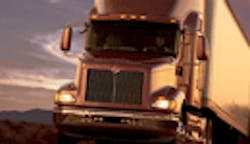Navistar, the only U.S. engine maker that intends to only use EGR (exhaust gas recirculation) to meet EPA 2010 emissions regulations rather than add SCR (selective catalytic reduction), said using EGR alone is a simpler solution for personnel, technicians and drivers during a briefing held exclusively for Penton Transportation Group editors.
“We made the choice around environmental, performance, customer-friendliness and performance issues,” said Tim Shick, Navistar director of business and product strategy. “For 2010, our solution is an in-cylinder solution, essentially continuing on the same path we have been on… There are no added components, weights, or training for the Navistar solution.”
According to Shick, the SCR approach does improve fuel economy, but he said the company’s research showed by volume the amount of urea added equals the amount of diesel fuel saved. Additionally, SCR requires more sensors and diagnostics, additional hardware “and a complex control strategy,” he said.
Also, Shick said urea is not available at all fueling stations, and it’s hard to predict what prices for it will be, adding that an SCR system will add 400 lbs. to the truck and will require extra training for all technicians and drivers on how to use the system.
Navistar’s EGR solution is different, Shick said, noting that it is “a mature technology with a proven track record.” According to Navistar, EGR has no adverse economic impact over the product lifecycle, no added weight or urea distribution concerns, and reduces operational maintenance and serviceability issues.
For 2010, EPA has reduced the maximum NOx emissions to 0.2 grams per horsepower hour (g/hphr), down from 4.0 in 1998, 2.5 in 2002, and 1.2 in 2007. Shick said Navistar will be unable to get NOx below 0.2 by 2010, but will be able to delay meeting that standard by using credits the company has received for previously producing enough engines of all types that performed beyond emissions standards.
According to Shick, Navistar is below 2007 NOx standards now and will continue to work to lower emissions, expecting to get below the 0.2 barrier by 2012. This will be accomplished by raising injection pressures and through electronic calibration, increasing the EGR rate and optimizing combustion. The challenge, he added, is not attaining 0.2 with EGR, but retaining fuel economy and performance at that level.
Earlier this year, Navistar extended its engine supply agreement with Cummins for 2010 engines, before Cummins announced it would use SCR. According to Debbie Shust, director of Navistar’s heavy truck vehicle center, the OEM is still in negotiations with Cummins over continued use of its engines.
SCR was brought to the U.S. from Europe in the early part of this decade, taking a stationary technology originally used in powerplants and adapting it for mobile applications, according to Navistar. However, said Shick, some European companies have begun to go back to EGR for Euro 5 regulations. “At some point, the ideal technology will come to the forefront, and it’s obvious which one we believe it will be,” he said.
See also: Making EGR-only work for 2010
